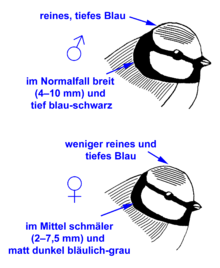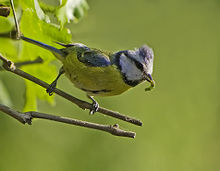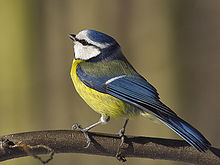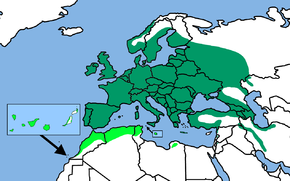Eurasian blue tit
![]()
This article is about the bird blue tit; for the Austrian dialect term, see subungual hematoma.
The blue tit (Cyanistes caeruleus, Syn.: Parus caeruleus) is a species of bird of the genus Cyanistes in the family Tit (Paridae). The small bird is easy to identify with its blue-yellow plumage and is very common in Central Europe. Its preferred habitats are deciduous and mixed forests with a high proportion of oak trees; the blue tit is also often found in parks and gardens. Apart from Europe, it occurs in some neighbouring areas of Asia, in North Africa and in the Canary Islands. The Canary Islands population is often considered a separate species (African Blue Tit, Cyanistes teneriffae).
The blue tit prefers animal food, especially insects and spiders. Outside the breeding period, the importance of seeds and other plant food increases. When foraging, the blue tit is conspicuous for its dexterity; it can cling to the outermost branches and also search for food while hanging upside down.
Blue tits usually breed in tree hollows, nest boxes are also frequently accepted. The main competitor for nesting cavities and food is the much larger great tit.
Appearance and characteristics
With a body length of just under twelve centimetres, the blue tit is significantly smaller than the great tit. The light blue plumage on the head and upperparts does not occur in any other songbird in Central Europe and thus allows easy identification. The dark horn-brown bill is short and high compared to that of related species. The iris is brown, the feet are dark blue-grey, the claws grey.
Plumage and moult
In the head area, the plumage of the blue tit shows a very typical pattern, which appears less contrasting than in the sister species due to the absence of black plumage parts. The forehead, which is white from the base of the bill to the front corner of the eye, merges at the top into the characteristic light blue head feathers. The feathers in the crown area can be erected to form a low, blunt cap. A narrow black eye stripe extends from the base of the bill to the dark blue nuchal band, which is separated from the light blue head plate by a white stripe. The cheeks, also white, are bordered in front by a black throat patch and chestward by a black and blue throat ring.
The back and shoulders are dull greenish, with the hue varying between populations. The rump is grey-blue and blends smoothly into the upper tail coverts. The light blue control feathers are usually very dark at the keel and sometimes have a white fringe or edge. The breast, flanks and belly sides are bright yellow, the intensity of the colouring can vary greatly from individual to individual. In the middle of the underside of the rump there is a longitudinal black line, but this can also be partially covered by the surrounding feathers. The wings are blue on top with a white wing band, and the individual wing feathers are multicolored. Blue tits of other colours are extremely rare.
In addition, the plumage has a very distinctive patterning in the ultraviolet range, which is not visible to the human eye. These colour variations obviously play a role in mate choice. In the meantime, it has been proven that many other bird species can perceive ultraviolet light and that the plumage of such species also shows a reflection maximum in the ultraviolet range. However, it has turned out as a special feature that the blue tits show a kind of "ciphered" sexual dimorphism, because in the ultraviolet spectrum of light the sexes are clearly distinguishable in contrast to the visible range.
Young birds can be identified until the autumn of their first calendar year by the pale yellow colouring in the head area, as the change in head plumage only begins at the end of the juvenile moult, which takes place from mid-July to the end of October of the hatching year. Even after the juvenile moult, they can be distinguished from the adults by the clear difference in colour between the arm coverts, which are renewed during the moult, and the hand coverts, which remain intact. The new arm covers show the typical blue colouring, the hand covers are more greenish.
The annual moult of the adults is a postnuptial ("after the wedding") full moult and begins on average six weeks before the moult of the young birds. The beginning of the moult usually still falls into the phase of rearing the young. The entire change takes 115 to 120 days, which is unusually long for a bird of this size. The moulting pattern is similar to that of most other passerine birds.
Sexing
A slight sexual dimorphism is present in some characteristics, but this does not allow all individuals to be clearly assigned. The most helpful plumage characteristics for sex differentiation are the width and coloration of the collar and the color intensity of the blue head plate (see adjacent figure). In addition, the male has more white on the forehead, wing band and control feathers.
With the subspecies of the teneriffae-group (see systematics), the differences between males and females are clearly smaller and the sexes externally hardly to distinguish.
Dimensions and weight
On average, males are larger than females, but there is an area of overlap. There are sometimes considerable differences in size between the different subspecies, which can be seen when comparing wing lengths. The birds from Western, Central and Northern Europe are on average larger than their Mediterranean relatives. Even within the nominate form, wing length decreases from the northeast to the southwest. Towards the southeast there is again a tendency towards longer wings, especially in the subspecies in the Middle East. In the nominate form, the wing length of males is between 65 and 71 millimetres, that of females between 62 and 67 millimetres. The tail length is on average 51.5 millimetres in the male, 49.6 millimetres in the female.
On average, males are heavier than females. The weight of blue tits is subject to strong seasonal fluctuations, it reaches its maximum in early winter, in females shortly before egg laying, only at this time they are heavier than males. With sufficient food supply, the weight is highest in severe winters. Animals from Scandinavia weigh more than those from Central Europe, in Finland an average of 12.1 grams was measured for males and 11.4 grams for females, in Eastern Germany it was 11.5 and 11.0 grams respectively.
Voice
The typical territorial song of the blue tit begins with two to three high-pitched, very similar sounds at a frequency of about 8 kHz, usually transcribed as "zizi" or "zizizi". These are followed by a trill at a slightly lower pitch, consisting of 5 to 15, in exceptional cases even up to 25 shorter elements. These stanzaic parts are quite uniform compared to those of other tits. However, there is also a stanzaic form that can be confused with the song of the great tit. Between the introduction and the trill, a middle section consisting of a few but very variable elements is occasionally interposed. Sometimes these strophes, consisting of two or three phrases, are strung together immediately; the final series of sounds is then often shortened.
A male has three to eight different such strophic types. Territorial singing also occurs occasionally in females, for example when they are involved in territorial disputes. The typical trill at the end of the stanza occurs less frequently in Mediterranean birds. This is obviously due to the fact that there, in contrast to northern and central Europe, there is no such strong competition with the great tit. In the more northerly blue tits the trill seems to be necessary to distinguish the song from the great tit, for it has been shown experimentally that great tits respond equally strongly to blue tit song without trill as to species-specific song. The territorial song of African blue tits is still very different from the nominate form. It does not contain phrased strophes, but more variable elements. The song differs so much that Central European blue tits do not respond to strophes of the representatives from Tenerife.
In the calls of the blue tit, two different types of alarm calls are very significant and can be clearly distinguished. The alarm for flying prey is a very high-pitched, drawn-out "ii". This alarm call is very similar to the warning call uttered in a similar situation by other songbirds and is also understood across species. Another important call of the blue tits, the so-called clamor, is heard in cases of strong excitement, territorial disputes, approaching ground enemies and hating sitting birds of prey. This second alarm sound does not show such a strong interspecific agreement, but is probably correctly interpreted by other species.

Secondary sexual characteristics of the feathering, above male, below female

Foraging Younger Blue Tit

Adult Blue Tit

Older fledgling
Distribution, habitat and migrations
Distribution
The distribution range of the blue tit is restricted to the western Palearctic except for two small areas in the north and south of Iran. Europe is widely populated except in the north. There are gaps in its distribution in the high altitudes of the Alps and presumably also in some mountains in the Balkans, although in many places only insufficient data are available for the latter.
The blue tit is absent from Iceland as well as the northern part of Scotland and many of the offshore islands. The Outer Hebrides were not colonized until 1963. In Scandinavia, the distribution is limited to the southern parts of the country and the lowland regions; the high mountain ranges are not populated. The northern limit of the range in Norway is approximately 67° north latitude, in Sweden the closed breeding area in the mixed forests extends to about 61°, in the coastal area in a narrowing strip to 65° north latitude. In Finland, the distribution also extends northwards to about 65° latitude, and in the course of the 20th century the blue tit has expanded its range there considerably to the north. From southern Finland the northern limit of the range extends south-eastwards across Bashkiria to the southern foothills of the Urals. The eastern boundary of the range is complex and probably subject to constant change. It is conceivable that there is an interdependence with the limit of the range of the Lazur's Tit, which keeps advancing westwards.
In the south, the blue tit populates Asia Minor and northwest Africa, including the Canary Islands, in addition to Iran. In Morocco, the range extends south to the southern foothills of the High Atlas, in Algeria to the Sahara Atlas and in Tunisia to the height of Sfax. In Libya, an isolated occurrence exists in northwestern Cyrenaica. An attempt to naturalize it in New Zealand in 1871 was unsuccessful.
Habitat
According to their wide distribution, blue tits colonize different habitats. In Central Europe, the highest settlement densities and breeding successes are achieved in oak-rich deciduous and mixed deciduous forests. The pure oak forests, which are very rare in Central Europe, are very attractive despite their small area. Much more frequent are various types of mixed oak-hornbeam forests, which also offer the species very good living conditions, as well as hardwood floodplains with a high proportion of oak. Somewhat less favourable are beech and mixed beech forests, which, however, are still quite densely populated. In mixed coniferous forests, the number of blue tit territories depends strongly on the presence of individual deciduous trees. In pure coniferous forests, the Blue Tit is absent or at best colonizes the forest edges. Both in the Alps from the montane altitudinal stage onwards and at the northern limit of its range in Scandinavia, mixed forests with a comparatively high proportion of deciduous wood are largely avoided. The settlement density, for which a maximum value of 1.85 breeding pairs per hectare was determined, is largely independent of the territory size, which lies between 0.16 and 0.84 hectares. At high settlement densities, the territories border directly on each other.
In addition to forests, the blue tit is also found in the vicinity of humans, inhabiting a variety of habitats, including those more strongly influenced by anthropogenic activity. These include semi-open cultivated landscapes with interspersed trees and hedges, orchards and parks. Probably due to competition from the great tit, population densities in settlement areas are far lower than in woodland. The blue tit needs a higher number of old trees than the great tit, but can use irregularly distributed prey more efficiently.
In general, the blue tit is a bird of the lowlands, in the mountains the occurrences are largely concentrated in the valleys. The altitudinal limit of distribution is much lower in isolated mountain ranges than in closed massifs: In the Harz Mountains the limit is 550 metres, in the Alps between 1,300 and 1,700 metres and in the Pyrenees at about 1,800 metres, in the Caucasus at 3,500 metres. A comparison of long-term observation data often shows an upward shift in the altitude limit, which is probably due to global warming and habitat changes caused by forest dieback.
In southern Europe, the habitat requirements are lower. The same applies to the low altitudes of the range in the Middle East, where blue tits can also be found in coniferous forests. The habitats of the populations in North Africa differ for the most part considerably from those of Central European representatives. They also inhabit montane coniferous forests dominated by junipers, cypresses and pines, as well as very dry habitats such as palm oases on the northern edge of the Sahara.
The Canary Islands are another special case, as the strongly preferred oaks do not occur there at all. There, the blue tit benefits from the fact that no other tit species has colonized this Atlantic archipelago. This lack of competition is evident in behavior and habitat selection; there, blue tits show a marked widening of niches. Habitats include palm groves, copses formed by tamarisk, montane forests of Canary Island pine, and the evergreen laurel forests of the island north sides. Breeding burrows are also found in the extremely arid dry scrub of southern Tenerife in the stem succulent shoots of candelabra spurge.
Outside the breeding period, habitat specificity is generally significantly reduced. When favourable food sources are available, the birds even visit treeless areas such as reed beds, pastures or exposed coastal cliffs.
Hikes
The blue tit is a resident or partial migrant within its range, with dismigration being quite pronounced, especially in young birds. Migration behaviour can change within a few generations. Also, individuals of a population often show a very different readiness to migrate.
Fidelity to the place of birth seems to be relatively low, but it is debatable whether the extremely low capture rate of young ringed birds at the place of birth is due to dismigration or high mortality. The birds dismigrate in an undirected manner, females on average move further away from the place of birth than males. A study in Brunswick found that over 90 per cent of birds settle less than three kilometres from the birthplace, further than ten kilometres from the birthplace 2.9 per cent of females and 0.7 per cent of males were encountered.
In central, eastern and northern Europe, there are individuals that remain in the breeding area for a long time, as well as those that show some of the typical characteristics of migrants; in Great Britain, however, the birds are all resident. In the other areas, weak migration is towards the south-west, beginning in late August, when the large plumage is largely moulted, and peaking about the end of September. A very weak home migration takes place between March and April. The greatest distances recorded during actual migration are around 1500 kilometres. Females participate more often in migration, moreover mainly younger and socially low birds.
Invasion-like migrations, as they regularly occur with the Coal Tit, are much rarer and less pronounced with the Blue Tit. Sometimes such migrations occur several years in a row, on the other hand almost 20 years can lie between such invasions. Mild winters with subsequent above-average breeding success are assumed to be the cause.
Furthermore, spatially more restricted vertical migrations also take place; the birds of the mountains are partly found at significantly higher altitudes in early autumn than during the breeding season. The reason for this is probably the favourable autumn food supply in this habitat. In high winter, a clear valley migration can be observed; in general, blue tits are more often found in human settlements in winter, which seem to be attractive due to artificial food sources; to what extent this is favourable for the survival of the birds is unclear.
In southern Europe, and moreover in all subspecies except the nominate form, the migratory behaviour seems to be at least partly much less pronounced.

The "primeval forest" Sababurg represents an optimal habitat for blue tits

Distribution area of the blue tit: dark green: caeruleus grouphell green : teneriffae group
Questions and Answers
Q: What is a blue tit?
A: A blue tit is a passerine songbird in the family Paridae.
Q: How long is a blue tit?
A: A blue tit is 10.5 to 12 cm (4.2 to 4.8 inches) long.
Q: Is the blue tit a common bird?
A: Yes, the blue tit is a widespread and common resident breeder.
Q: Where does the blue tit live?
A: The blue tit lives throughout temperate and subarctic Europe and western Asia in deciduous or mixed woodlands.
Q: Does the blue tit migrate?
A: No, the blue tit is a resident bird and most do not migrate.
Q: What is the family of the blue tit?
A: The blue tit belongs to the family Paridae.
Q: What is the scientific name of the blue tit?
A: The scientific name of the blue tit is Cyanistes caeruleus.
Search within the encyclopedia